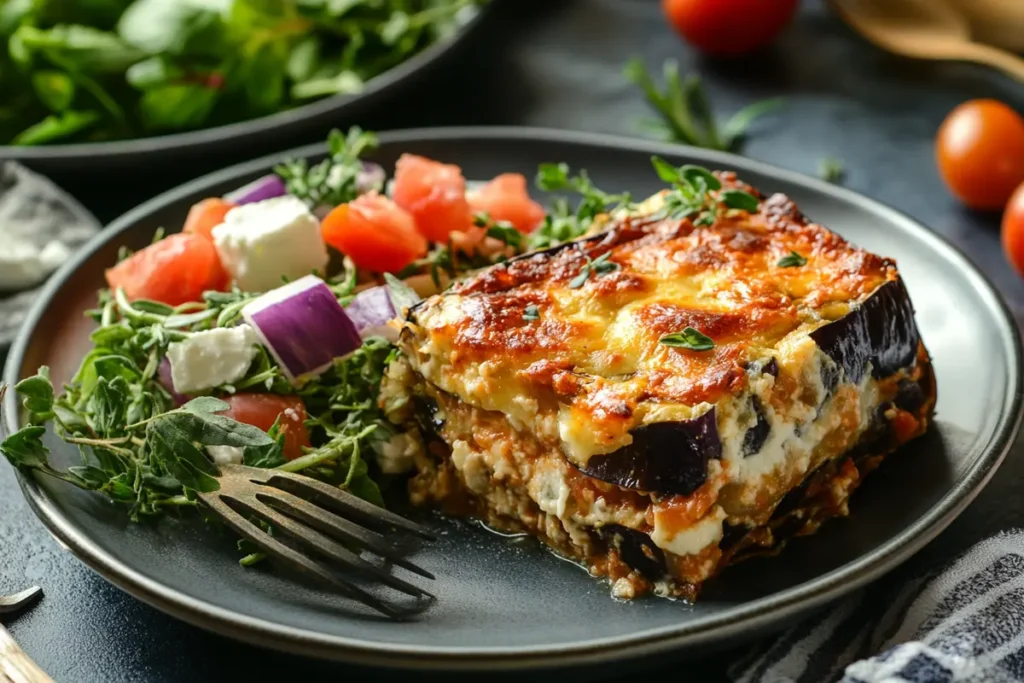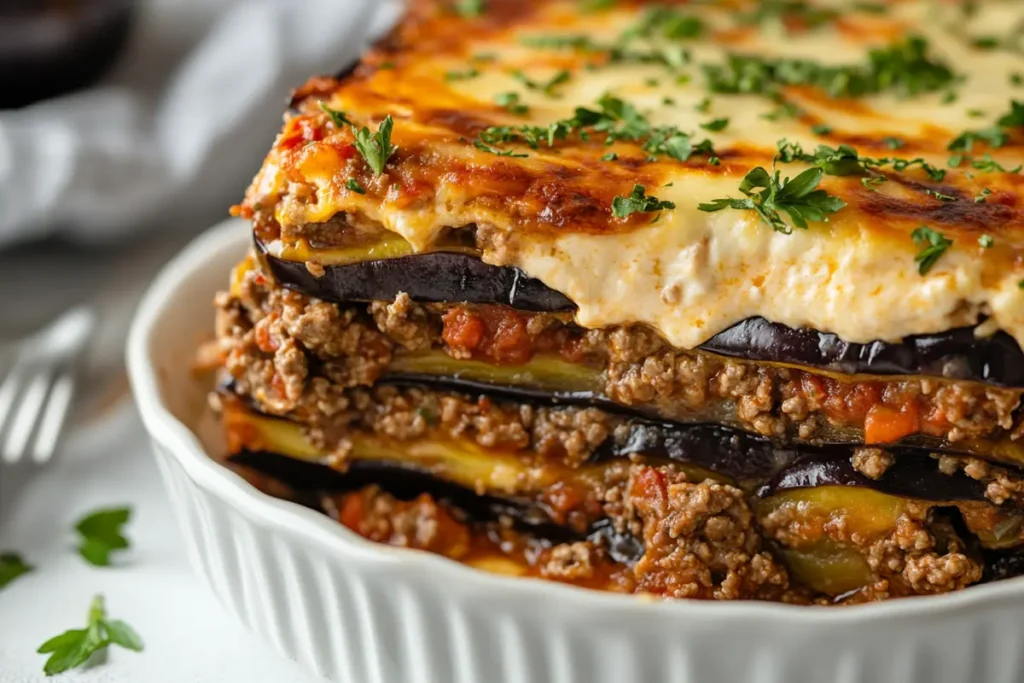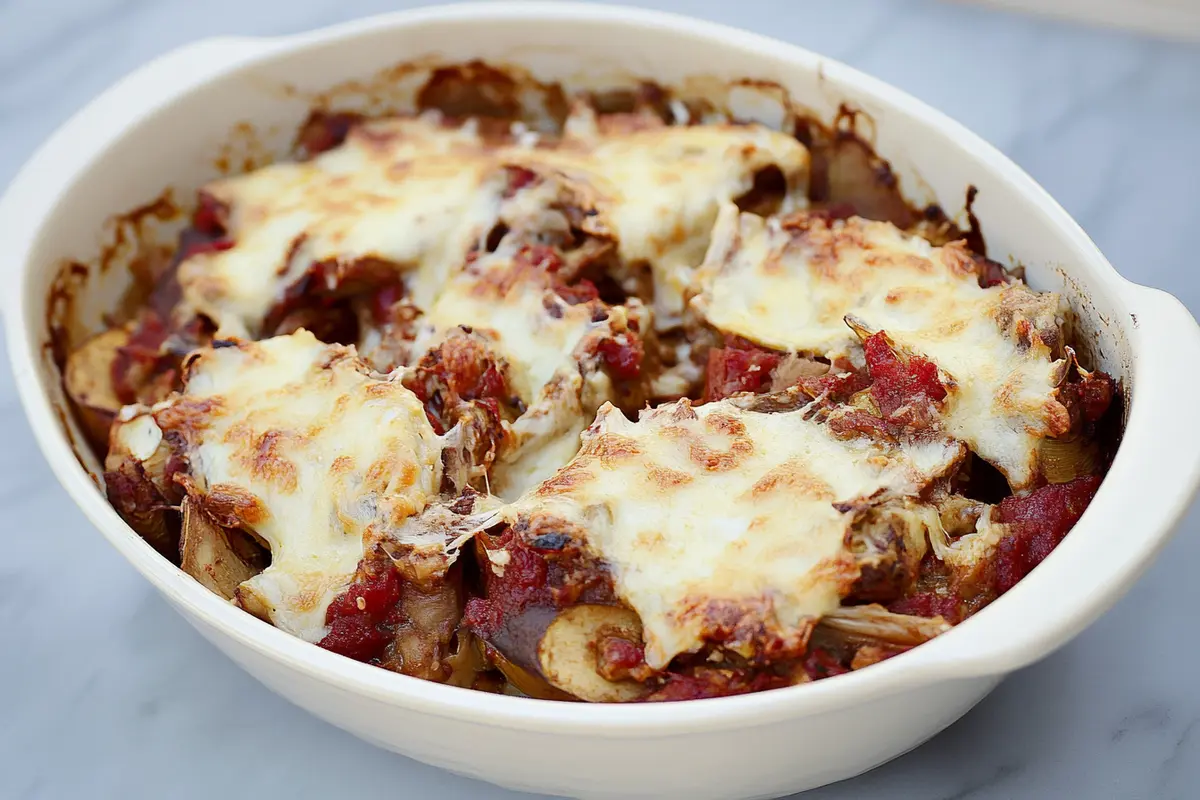Explore the rich taste of eggplant casserole Greek, a traditional dish with layers of flavor. This guide provides tips and techniques to make it at home.
Table of Contents
Discover the Essence of Eggplant Casserole Greek
Eggplant casserole Greek is a beloved dish. A staple in Greek culinary traditions, its flavor is very satisfying. It is a layered dish with rich flavors. The appeal of eggplant casserole Greek stems from its blend of simple ingredients. These ingredients create a complex and comforting taste. Often, this casserole is a centerpiece at family meals; it is a true taste of Greece.
Understanding the Traditional Components of Greek Casserole
A traditional eggplant casserole Greek has distinct components. Eggplant is very important; it is usually fried or baked. Then, there’s a flavorful meat sauce, typically lamb or beef. A creamy béchamel sauce is used next. Finally, there’s a touch of cheese. All these ingredients come together perfectly. Therefore, you get a memorable meal.
The Rich History Behind Authentic Eggplant Casserole Greek
The history of eggplant casserole Greek extends back centuries. This dish was created as a way to use seasonal vegetables. Furthermore, it has become an iconic part of Greek food. It represents the heart of Greek culinary heritage. It is more than just a meal; it’s a connection to history.
Preparing Your Eggplant the Greek Way
Preparing the eggplant correctly is important. It ensures the casserole has the right texture. Consequently, follow these simple steps.
Slicing and Salting: A Necessary Step
Slicing the eggplant is important. Make slices that are about 1/4 to 1/2 inch thick. Then, salt the slices generously. Doing so helps remove moisture and reduce any bitterness. After salting, let them sit for 30 minutes, rinse, then pat dry. These steps improve the flavor and texture.
Frying vs. Baking: Which Method to Choose?
For the traditional method, the eggplant is fried. Frying gives it a nice texture while adding flavor. Baking, however, is a healthier option. You can bake it with a bit of olive oil. Both ways will work, based on your needs and preferences.
Pre-cooking the Eggplant for Casserole Success
Pre-cooking eggplant is usually done for the traditional version. You can fry it lightly or bake it until tender. This reduces the bake time of the final casserole. Therefore, this step is useful.
Crafting the Hearty Meat Sauce
The meat sauce is key to the eggplant casserole Greek. Its flavor adds depth to the dish. Therefore, making it right is essential.
Selecting the Right Type of Meat for Authentic Flavor
Traditionally, lamb is used for the sauce. Ground lamb is the most common choice. Beef, however, is also a very good option. The key is to use good quality meat. The type of meat affects the flavor.
Seasoning the Meat Sauce with Greek Spices
Seasoning is what makes the sauce special. Use oregano, garlic, and cinnamon. A bit of allspice can also be added. Tomatoes are also part of the base. These spices add warmth and depth. This blend of seasoning is indeed essential.
Simmering the Meat Sauce for Richness
Simmering the sauce is very important. It helps to develop the flavors. Let the sauce simmer for at least 30 minutes. This allows the flavors to blend well. Thus, a well-simmered sauce enhances the overall dish.
The Creamy Béchamel Sauce: A Greek Essential
Béchamel sauce adds a luxurious touch. This sauce is a must for a traditional eggplant casserole Greek. Hence, it’s essential to get this right.
Making a Smooth and Creamy Béchamel
A smooth béchamel is crucial. Start by melting butter in a pan. Then, add flour to make a roux. Slowly whisk in milk until smooth. Season with salt, pepper, and a bit of nutmeg. Therefore, ensure it has a smooth consistency.
Adding Cheese and Flavor Enhancers
You can add cheese to the béchamel. Parmesan is a great choice. It adds a salty flavor. Some also add egg yolks to enrich the sauce. Small changes like these make a big difference; this enhances the flavor.
Achieving the Right Consistency
The béchamel should be thick and pourable. It should coat the back of a spoon. If it is too thick, add a bit more milk. The consistency is key to the casserole.
Layering Your Eggplant Casserole Greek
Layering is key for a well-constructed casserole. It ensures all ingredients are evenly distributed. Therefore, follow these steps closely.
The Order of Layers for Maximum Flavor
The correct order of layers is important. Start with a thin layer of the meat sauce. Then add a layer of eggplant. Next, add some of the béchamel sauce. Repeat these layers. Finish with a layer of béchamel and cheese on top. These layers are necessary to get the flavor right.
Tips for Evenly Distributing Ingredients
Ensure to spread each layer evenly. This ensures each bite has all the flavors. Do not overcrowd the casserole dish. Even distribution will result in a balanced taste.
Adding a Cheese Topping for a Golden Crust
Before baking, add a layer of grated cheese on top. Kefalotyri or parmesan are great choices. This cheese will create a nice golden crust. Consequently, this adds both taste and texture.

Baking Your Eggplant Casserole Greek to Perfection
Baking is the last step in making this dish. It brings all the flavors together. Thus, it’s important to get it right.
Ideal Oven Temperatures and Baking Time
Typically, you bake the casserole at 375°F. It takes about 45 to 60 minutes. However, baking times can vary. Watch closely to see that the cheese is golden brown. It’s crucial to check often.
Signs of a Perfectly Baked Casserole
The casserole is ready when it’s bubbly. The top should be golden brown. You should also be able to insert a knife into the center without resistance. These signs indicate that it is done.
Resting the Casserole Before Serving
Allow the casserole to rest for about 15 to 20 minutes. This allows it to set, making it easier to serve. Furthermore, it will help the flavors to combine fully. Therefore, resting the dish is very important.

Serving Your Eggplant Casserole Greek
Serving eggplant casserole Greek is an art that can enhance the dining experience. Consequently, follow these suggestions.
Traditional Side Dishes That Compliment the Casserole
A simple Greek salad is an ideal side. You could also serve some crusty bread. Additionally, some roasted vegetables would be a great addition. These side dishes enhance the main meal.
Wine Pairing Suggestions for Greek Flavors
A light to medium-bodied red wine pairs well with this dish. Greek wines such as Agiorgitiko are a great pairing. You could also choose a dry rosé. These wines will enhance the Greek flavors, as wine pairing elevates the dining experience.
Garnishing and Presentation Tips
A sprinkling of fresh parsley on top is great. A little drizzle of olive oil adds some shine. Small touches like these can make a big difference. Hence, presentation is key to a great experience.
Healthier Ways to Enjoy Eggplant Casserole Greek
You can also make this dish healthier. Here are some suggestions for modifications.
Substituting Ingredients for Lower Calories
Use less cheese and choose lean ground meat. Reduce the amount of olive oil. You could also use whole wheat flour for the béchamel. These changes can lower the calories.
Adding More Vegetables for Extra Nutrients
Increase the amount of vegetables. Add some spinach or mushrooms. Zucchini is another great addition, boosting the nutritional content. More vegetables are always a good idea.
Using Low-Fat Alternatives Where Possible
Choose low-fat dairy and low-fat cheese. These small changes make it healthier. Using low-fat versions reduces the fat content.

Eggplant Casserole Greek for Special Diets
You can adjust this dish for various diets. It’s very adaptable, so you can enjoy it no matter your preferences.
Creating a Gluten-Free Version
To make a gluten-free version, use gluten-free flour for the béchamel. Check all ingredients to ensure they are gluten-free. Therefore, those with gluten intolerance can also enjoy it.
Making a Vegetarian Eggplant Casserole Greek
To make it vegetarian, use lentils instead of meat. You can use a mix of vegetables instead. Make sure your broth is also vegetarian. Thus, you can still have a flavorful dish.
Lactose-Free Adaptations
If you need a lactose-free dish, use lactose-free milk and cheese. You could also use plant-based dairy alternatives. This ensures it is lactose-free.
Storing and Reheating Your Eggplant Casserole Greek
Knowing how to store and reheat is beneficial, allowing you to enjoy leftovers. Therefore, follow these steps.
Best Storage Methods for Leftovers
Store leftover casserole in an airtight container. Keep it in the fridge for up to three days, letting it cool before storing. Thus, it will stay fresh for a while.
Reheating for Texture and Flavor
Reheat in the oven for best results. This keeps the texture. The microwave also works but may change the texture. Therefore, choose your reheating method carefully.
Freezing Your Eggplant Casserole Greek for Later
You can also freeze this dish. Put it in a freezer-safe container. It can stay frozen for up to three months. Make sure it is completely cool before freezing. Freezing helps save time.
Eggplant Casserole Greek: A Dish for All Occasions
Eggplant casserole Greek is great for any event. It is a versatile and satisfying dish. Therefore, it is always a hit.
Eggplant Casserole Greek for Family Gatherings
This dish is perfect for family dinners. It is a great way to bring everyone together. Its comforting flavors appeal to all. Therefore, it’s a wonderful choice for family time.
Making It for Special Occasions
It’s also great for special occasions since it can be made ahead of time. Its rich flavor makes it special, hence it is always a crowd pleaser.
Adjusting for Different Tastes and Preferences
The best thing is that you can change it by adding different spices, using different types of cheese, and adding more or fewer vegetables. This makes it a dish for everyone.
Extra Tips for the Perfect Eggplant Casserole Greek
Here are some extra tips for perfection, which will make your dish even better.
Adding a Touch of Fresh Herbs
Add some fresh herbs on top. Parsley and mint are great options. They add a fresh flavor and visual appeal. Fresh herbs enhance this dish.
Using High-Quality Olive Oil
Use good quality olive oil, as it will enhance the overall flavor. It is a staple in Greek food, and therefore, good olive oil is very important.
Don’t Skip the Resting Time
Resting time after baking is essential. It makes it easier to serve and allows the flavors to blend. Therefore, do not skip the resting time.

Conclusion: Enjoying Authentic Eggplant Casserole Greek
Eggplant casserole Greek is a fantastic dish, full of flavor and very comforting. Enjoy making this traditional meal. With a few simple steps, you will have a delicious dish.
Frequently Asked Questions (FAQs)
Why do you soak eggplant in milk?
Some people soak eggplant in milk, believing this reduces its bitterness and makes it more tender.
What does moussaka literally mean?
Moussaka is an Arabic word, and it literally means “chilled.”
What is Greek moussaka made of?
Greek moussaka is typically made of eggplant, a meat sauce, and a béchamel sauce.
What is the difference between Turkish and Greek moussaka?
Turkish moussaka often uses more vegetables and less sauce, while Greek moussaka features a rich meat sauce and a thick béchamel topping.
For More Delicious Recipes:
Easy Naturally Low Carb Smoothies
Is Almond Milk Naturally Low Carb?

